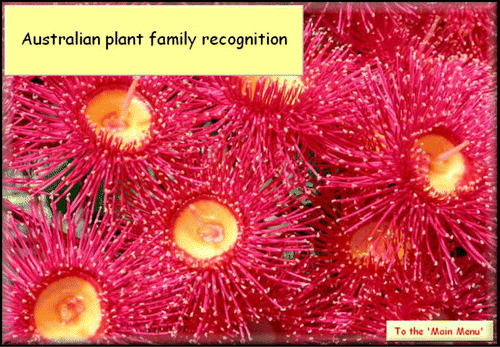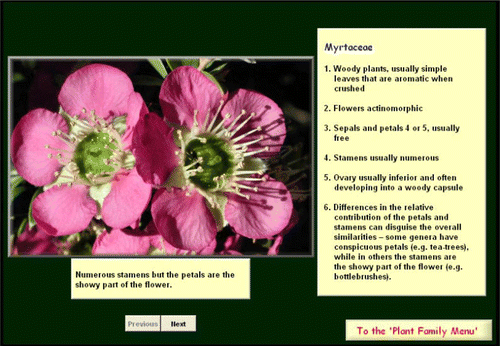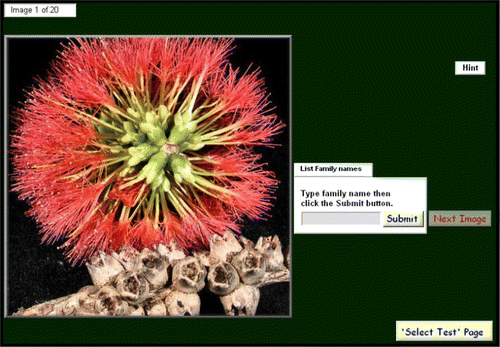Abstract
Plant families are the level of the taxonomic hierarchy that many biologists use to organise their understanding of plant diversity. Consequently, from many perspectives, it is very useful to be able to recognise the major plant families ‘on sight’. To this end numerous books and web sites have described and illustrated plant families, but few resources are available for students to test their recognition skills. The application described in this paper features an illustrated tutorial for 11 of the largest plant families in Australia (they cover over 50% of Australia’s plant species), augmented with a series of interactive tests. The tests are organised in five groups of 20 high quality images. Each image is supplemented with optional hints to the main features of flower structure and an optional reminder of the family names. The web site is one part of an integrated series of activities to assist students to recognise some of the most important plant families and thus master a very useful practical skill.
Introduction
There are probably somewhere between 223,000 and 420,000 species of seed plants in the world (e.g. CitationGovaerts 2003). It is important to be able to classify, name and identify this diversity. Given the vast numbers of species and genera, families have been recognised as a convenient level for organising how we perceive and understand this diversity. The ability to recognise plant families is a very useful skill for bioscience students and is an important component of many plant taxonomy subjects. In this paper ‘Identification’ means the observation and assessment of various characteristics and their analysis through mechanisms such as keys. ‘Recognition’ means the ability to ‘know’ the family of a plant specimen, based on prior experience and knowledge of the family. In other words, an almost instantaneous assessment of the whole, rather than the processing of a series of successive questions. Some benefits of family recognition include:
If an unknown plant specimen is encountered it is more efficient to start keying out at a known family, rather than beginning at the very start of a key.
In illustrated Floras it significantly reduces the number of images that need to be examined and thus markedly improves the efficiency of identification.
Environmental science, agronomy or horticulture students can work more efficiently in the same country at locations away from where they received their training and also overseas, as several of the largest plant families are cosmopolitan in their distribution.
Leisure activities such as walking and gardening can be more rewarding as ‘you’ are actually observing more.
While considerable resources are available regarding the description of the major plant families, few are available for people wishing to develop and evaluate their family recognition skills. To this end I have developed an integrated web-based tutorial and tests for the recognition of some of the major Australian plant families. Clearly the 100 test images have an Australian emphasis, though many of the examples used for families such as the Asteraceae, Brassicaceae, Fabaceae, Lamiaceae and Poaceae are not from Australia. Readers from the northern hemisphere will see several families they will be quite familiar with but perhaps with examples less well known to them. The Australian Plant Family Recognition (APFR) application is an example of what can be done. The ‘In the classroom’ section describes universally applicable approaches to learning plant families and the ‘Other resources’ section highlights the few other comparable resources. With this information assembled in the one article it is envisaged that readers interested in designing their own resources can assess the best features.
The application
The web site (www.csu.edu.au/herbarium/ and click on ‘Australian Plant Family Recognition’) () follows the format of providing an illustrated tutorial, augmented by tests based on images not used in the tutorial, ensuring that users apply their knowledge to a new set of data (CitationBurrows 2010a,b).
Figure 1 Home page of the Australian Plant Family Recognition application, featuring the flowers of a cultivar of the red flowering gum (Corymbia ficifolia, Myrtaceae)

The families included in the application were selected to meet the skill requirements of agriculture, horticulture and environmental science students at Charles Sturt University. Thus, the 11 families () include the seven largest (in terms of the number of species) families in Australia, but also includes families such as the Brassicaceae and Lamiaceae that have a wide range of native species, introduced species, species and cultivars found only in gardens and are large families on a world-wide basis. These 11 families include over 50% of Australia’s plant species. Currently the circumscription of the Fabaceae is generally viewed in a broad sense, consisting of three subfamilies - Faboideae, Mimosoideae and ‘Caesalpinioideae’ (CitationJudd et al. 2008). The three subfamilies are, in some classifications, regarded as separate families and are treated this way in the application, as they have very different flower structures to recognise.
Table 1 Families covered in the Australian Plant Family Recognition web site. Worldwide (WW) species and genera numbers are from the APG (Angiosperm Phylogeny Group) web site (accessed September 2009). Australian species and genera numbers are from Sjostrom and Gross (2006). For the Fabaceae and the Mimosaceae the upper row of data comes from the APG web site, while the lower row comes from the Flora of New South Wales, Vol. 2.
A major part of the tutorial is a guide to the families that describes their ‘spotting’ characters ().
Figure 2 Tutorial page for the Myrtaceae featuring an image plus a listing of the ‘spotting’ characters

‘Spotting’ characters are the main features that will quickly allow recognition with the unaided eye or, at most, a x10 hand lens. The supporting images are different to those used in the tests and feature multiple images to show variation in families with notable differences (e.g. Asteraceae, Myrtaceae, Goodeniaceae) and flower dissections for some families (Fabaceae, Brassicaceae, Proteaceae).
At present there are five tests of 20 images each (). It is required that students commit the names of the 11 families to memory, however there is a button ‘List family names’ as a reminder if needed. Each test provides a balanced selection of images from the 11 families (i.e. most families have two images per test) and thus as students progress through the tests they can ascertain if their recognition skills are improving. A ‘Hint’ button indicates, if required, some of the main features of the specimen. An incorrect answer generates a box with a description of the specimen’s main features and an opportunity to have a second attempt. All images were specifically taken for this application and thus provide a consistently good level of morphological detail to recognise the pattern of family features.
In the classroom
Most of my Plant Taxonomy and Systematics students are enrolled in the distance mode and thus their practicals are presented in an intensive three day residential school. In the years before the APFR application was released I had tested the plant family knowledge of students at the beginning of their first practical session. I provided them with samples such as daisy, eucalypt, rosemary and Grevillea flowers and asked them to write what family the samples belonged to and why they had arrived at that answer. Most students had essentially no knowledge of plant families and those that did might know, for example, that Eucalyptus is in the Myrtaceae, but had no idea why. That is, they did not know what ‘makes’ the Myrtaceae and thus could not recognise other members of the family, or they might know that grevilleas and waratahs were in the same family but did not know what united them.
Although it is possible to become competent at recognising the 11 families over the course of the residential school the web site is designed so that students arrive well prepared for the residential school, thus making better use of their time on campus. To further assist in their preparation for the residential school students are required to construct a key to the these families as part of a pre-residential assignment. This helps them to focus on the most important recognition features.
While at the residential school the students dissect and prepare floral formulae for multiple specimens of most of these families. They then create their own family synopses based on their extremely limited number of samples and then we compare these to ‘textbook’ synopses and critically comment on the similarities and differences. During the residential school I hold impromptu tests, shown on the laboratory monitors, using images like those on the web site tests. With these numerous and varied approaches students are well prepared for the family recognition test at the end of the residential school and, subsequently, for recognising families in other subjects and in the workplace.
Other resources
Given their scarcity and their usefulness below are brief descriptions of four other plant family recognition web sites that feature tests.
University of California Davis, for PLS102 California Floristics. At the time of access (June 2010) the test database featured 76 families and 966 photos. One of the excellent features of the test is the ability to select the families to be tested upon and the length of the test. The Goodeniaceae, Proteaceae and Rutaceae are not covered. http://www.plantsciences.ucdavis.edu/courses/plb102/quiz/quiz_by_family.html
Reed College, Portland, Oregon for BIO332 Vascular Plant Diversity. The test features 29 families, 114 images in total and 3-5 images per family. This site has five families in common with the APFR application. During the test the names of the families are visible. http://academic.reed.edu/biology/courses/BIO332/quiz/index.html
Clermont College, University Cincinnati. The web site covers 31 families, with five in common with the APFR web site. It is necessary to run the cursor over ‘What Plant Family Is It?’ at the top of page to activate the test. All the family names are visible and are clicked on to enter the answer. The common name of the test specimen is also supplied. These two features assist in finding the correct answer. http://biology.clc.uc.edu/courses/bioall/plant%20families.htm
Iowa State University, for BIOL366 Plant Systematics. The site contains thumbnail images arranged in phylogenetic groupings. Clicking on a thumbnail results in a larger image, with a yellow rectangle above the image. After considering what family the plant in the image belongs to, when the cursor is placed over the yellow area the answer is revealed. http://www.eeob.iastate.edu/classes/bio366/tests.htm
Conclusions
The ability to recognise the major plant families is a very useful skill for many ecologists, horticulturists and agronomists. While there are extensive resources for learning plant family characteristics, little in the way of self-guided assessment is available in this area. The APFR application combines a tutorial and tests, both featuring high quality images. The application covers many of the largest families in Australia, many of which are cosmopolitan in distribution.
Acknowledgements
I thank Scott Black for his ToolBook expertise in converting my ideas and images into this application. I also thank the many people who have tested and commented on earlier versions and to John Harper for his helpful comments regarding the manuscript.
References
- BurrowsG. E. (2010a) A guide to the gynoecium. Journal of Biological Education, 44 (2), 93-95
- BurrowsG. E. (2010b) Teaching flower structure and floral formulae — a mix of the real and virtual worlds. American Biology Teacher, 72 (5), 276-280
- GovaertsR. (2003) How many species of seed plants are there? — a response. Taxon, 52 (3), 583-584
- JuddW. S., CampbellC. S., KelloggE. A., StevensP. F. and DonoghueM. J. (2008) Plant systematics: a phylogenetic approach. Sunderland, Massachusetts, USA : Sinauer Associates
